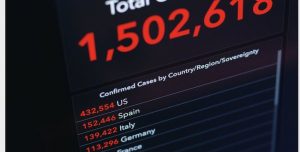Estimating the Number of SARS-CoV-2 Infections and the Impact of Mitigation Policies
 In late November, the Harvard Data Science Review published “Estimating the Number of SARS-CoV-2 Infections and the Impact of Mitigation Policies in the United States,” new research by HRDAG’s statistician Maria Gargiulo and director of research Patrick Ball, and colleagues Kristian Lum and James Johndrow. This model uses what we believe to be the most stable and reliable source of Covid-19 information—deaths—to estimate the epidemic curves.
In late November, the Harvard Data Science Review published “Estimating the Number of SARS-CoV-2 Infections and the Impact of Mitigation Policies in the United States,” new research by HRDAG’s statistician Maria Gargiulo and director of research Patrick Ball, and colleagues Kristian Lum and James Johndrow. This model uses what we believe to be the most stable and reliable source of Covid-19 information—deaths—to estimate the epidemic curves.
From the article’s media summary:
“Our analysis offers two findings. First, we estimate that the true number of COVID-19 infections is likely 6 to 10 times larger than the number of confirmed, officially reported cases as of late March. Second, we find that the first round of executive orders for social distancing had mixed effects across states. While in New York the effective reproductive number (a measure of the spread of the virus) dropped low enough to suppress the spread of the virus, this was less clear in states like Florida, where our estimates suggest that the executive orders caused the infection rate only to plateau rather than decrease.
Our model offers two technical improvements, in addition to these findings. First, we use what we believe is the most reliable, or least unreliable, source of data about the pandemic: reported deaths. Next, we build a Bayesian model that accounts for the time lag between infection and death.”
In April, when the pre-print of this research became available, HRDAG executive director Megan Price shared what she believes is novel and valuable about the approach, in this post.
Creative Commons
This article was published by the Harvard Data Science Review using a Creative Commons BY 4.0 license, with ownership retained by the authors.
Acknowledgments
We thank Alexander D’Amour for finding a misstated equation in an earlier version. We thank Amy Herring and David Dunson for comments on an early draft. This work was supported by grants to the Human Rights Data Analysis Group by the John D. and Catherine T. MacArthur Foundation and the Oak Foundation. Kristian Lum and James Johndrow acknowledge funding from NIEHS grant 3R01ES028804-03S. (For more information about HRDAG’s supporters, please see our Funding page.)
Find more articles about HRDAG research and resources regarding Covid-19.
